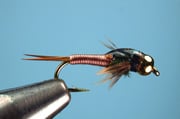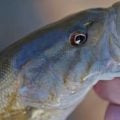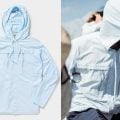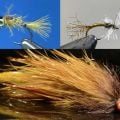
John Barr has invented a number of versatile and popular flies, among them the the fly that has become one of the most popular of modern patterns: the Copper John. Landon Meyer photo.
THE COPPER JOHN went through several design changes over a period of about three years beginning in 1993. The early patterns caught fish, but I didn’t consider it finished until 1996. After trying numerous hook styles, I settled on the Tiemco 5262, a 2XL, 2X heavy hook. (For those new to fly tying, this simply means a hook with a shank that is twice as long as a standard dry-fly hook, and wire that’s twice as heavy.) I tried many hook styles, but the proportions just came out the best on the Tiemco 5262, and it was a good strong hook.
In the first version, I wrapped natural-colored copper wire on the hook shank to form the abdomen. Because the fly had no underbody, the abdomen didn’t have any taper. The original pattern’s tail and legs were Hungarian partridge and the thorax was wrapped peacock herl with an epoxied turkey quill wing case. I first saw epoxy used to coat wing cases years ago on a Hal Jansen’s Callibaetis nymph pattern. The epoxy may give off a little glow that many emerging nymphs and pupae exhibit. I do not know if the epoxy makes the fly more effective, but it sure gives the fly curb appeal.
When Wapsi introduced Thin Skin, I began to use that instead of turkey quill for the wing case. Thin Skin is a versatile synthetic material that comes in sheets and can be used for wing pads, wing cases, and backs on nymphs. Thin Skin is durable, easy to work with, more readily available than turkey, and accepts the epoxy coating better than the turkey. The first layer of epoxy I used soaked into the turkey feather and a second coat was required.

The Copper John
I also changed the materials for the tail and legs. The partridge wasn’t very durable, so I switched from hen-back feathers to fibers for the legs and to goose blots for the tail. The hen-back fibers were durable and came in a variety of mottled colors.
To make the fly sink faster, I wrapped lead wire on the hook under the thorax. I chose the metal bead, lead, wire abdomen, and slim profile to achieve the fastest sink rate possible. I added a tapered thread underbody so the abdomen had a nice taper when the wire was wrapped over it. The fly was almost where I wanted it. The final piece was put into place when artist Dave Hall suggested pulling a single piece of pearl Flashabou over the top of the Thin Skin before applying the epoxy. The pattern was finished.
At first I only tied the fly in natural copper. Michael White, owner of Blue Ribbon Sales, who lives in Boulder, Colorado, suggested I try red and green wire. It took me a few years to try the red and green, which turned out to be productive colors. In spring 2001, Wapsi introduced Ultra Wire, a tarnish-proof wire available in a wide assortment of colors. The original copper-colored fly now shared space in my fly box with Copper Johns tied in red, green, chartreuse, silver, wine, zebra (black and silver), black, blue, and hot pink.
Tying Steps: Copper John
|
 |
 |
 |
| 1. Place the bead on the hook by inserting the hook point into the smaller hole on the front of the bead. Slide the bead up to the hook eye. Insert the hook into the vise. Wrap thirteen turns of lead wire onto the hook shank from the back of the hook to the front. |
2. Break off both ends of the lead with your thumbnail. Shove the lead wraps up into the back of the bead, countersinking the wraps into the recess. |
3. Start the tying thread at the back edge of the lead wraps. Build a smooth taper from the bare hook shank up to the lead wire and continue with a smooth thread base back to the bend of the hook. Leave the tying thread hanging at the bend. |
 |
 |
 |
| 4. Select two matched biots from the quill. Pull two that are right next to each other to assure that they are the same width and length. Place the biots back to back so they curve away from each other, and even their tips. Measure the biots against the hook shank so they are equal to one-half a shank length long. |
5. Place the opposed biots at the hook bend with one on each side of the hook shank. Turn them so they are slightly off-center toward the near side of the hook. |
6. Wrap two turns of thread over the biots to hold them in place on the near side of the hook. If you tie them in at a slight angle, thread torque pulls them onto the correct position. Pull the tying thread down to tighten the loops of thread and pull the biots on top of the hook shank. |
 |
 |
 |
| 7. Wrap forward over the butt ends of the biots to just in front of the hook point. |
8. Properly tied-in biot tails. |
9. Continue wrapping forward over the butt ends of the biots up to and onto the lead wraps. The butt ends will help build the taper to the lead wraps. |
 |
 |
 |
| 10. Clip the butt ends of the biots and wrap a smooth thread base from the base of the tail to the three-quarter point on the shank. The thread base should be as smooth as possible and have an even taper from front to back. |
11. Cut a length of copper wire about 6 or 8 inches long and tie it in at the front of the thread underbody on top of the hook. |
12. Wrap back over the copper wire to the base of the tails. Make several tight turns of thread coming forward from the bend to secure the wire. Keep these thread wraps as smooth as possible. |
 |
 |
 |
| 13. Continue forward with the thread to the front end of the abdomen. |
14. Begin wrapping the wire forward from the hook bend in tight, concentric turns. Tilting the wire back slightly as you wrap will allow the next wrap to roll off the edge of the previous wrap, butting the turns together. Continue wrapping the copper wire forward to the end of the thread underbody. Tie the wire off at the front edge of the underbody with two tight turns of thread. Clip the excess wire with a pair of nail clippers, or twist the remaining end around in a circle until it breaks off. Cover the stub end with a few turns of tying thread. |
15. Cover the lead wraps between the copper wire abdomen and the back of the bead with a thin layer of thread. Only use enough thread to eliminate the spaces between the lead wire. Tie in a single strand of pearl Flashabou directly on top of the hook and make certain that it is centered on the hook. Wrap back over the Flashabou and the front end of the copper abdomen so it is tied in back to the point shown. |
 |
 |
 |
| 16.Cut a strip of Thin Skin slightly narrower than the width of the hook gap. Leave the Thin Skin on the paper backing while you cut the strip. If you remove the whole sheet it will roll up into an unusable ball. After you cut the strip to the correct width, peel the Thin Skin strip from the paper backing.Tie the Thin Skin strip in on top of the hook shank at the front of the abdomen and wrap back over it to the 70 percent point on the hook shank. Tie the Thin Skin in with the shiny side (the side that was adhered to the paper backing) facing up. |
17. Wrap the thread forward to a point just behind the bead. |
18. Select five or six bushy peacock herls and trim their tips evenly. Tie the peacock in by its tips just behind the bead and wrap back over them to the base of the Thin Skin wing case. Return the thread to the back edge of the bead. |
 |
 |
 |
| 19. Wrap the peacock herls forward in tight, concentric, non-overlapping turns to the back of the bead and tie them off with a couple tight turns of thread. |
20. Clip the excess peacock flush. |
21. Pull a small clump of fibers from the side of a hen-back feather to align the tips. Peel the clump from the stem of the feather. |
 |
 |
 |
| 22. Lay the clump of hen fibers along the far side of the hook shank with the tips extending back to the hook point. Press the fibers against the hook with your index finger. |
23. Make two turns of thread over the hen fibers right behind the bead. |
24. Prepare and strip another like-sized clump of fibers from the hen feather. Tie this clump in along the near side of the hook. |
 |
 |
 |
| 25. Trim the butt ends from both clumps. |
26. Pull the Thin Skin forward over the top of the peacock thorax and tie it down right behind the bead. |
27. Pull the Flashabou over the top of the Thin Skin, making sure it runs down the center of the wing case. Tie the Flashabou down right behind the bead. |
 |
 |
 |
| 28. Close-up. |
29. Clip the butt ends of the Flashabou and the Thin Skin as close to the bead as you can. Build a smooth thread head and whip-finish the thread. |
30. Mix a small batch of epoxy and coat the wing case from front to back and side to side. It helps to run the epoxy up onto the back edge of the bead and down onto the wire at the back of the wing case. |











































